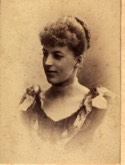Clement-Jones family - Person Sheet
Clement-Jones family - Person Sheet
NameGeorge Leary Joseph TAAFFE, 290
Birth26th April 1866
Death7th June 1923
FatherStephen TAAFFE , 496
MotherMary KELLY , 497
Spouses
Birth23rd October 1870, Trevalyn Hall
Death18th January1963, Northumberland
FatherBoscawen Trevor GRIFFITH BOSCAWEN JP , 8 (1835-1904)
MotherHelen Sophia DUFF , 7 (1834-1930)
Marriage18th July 1895, Brompton Oratory, Kensington, London
ChildrenGeorge Randal Joseph , 291 (1897-1979)
Rudolph Trevor Aloysius Patrick , 293 (1901-1985)
Maureen Helen , 296 (1910-1992)
Notes for George Leary Joseph TAAFFE
Of Smarmore Castle, Co Louth, Ireland
From: http://www.smarmorecastle.com/castlehistory.htm
Smarmore Castle has the distinction of being one of the longest continuously castles in Ireland. Records show that William Taaffe had his seat at the castle in 1320 after his family arrived in Ireland from Wales at the turn of the twelfth century. The Taaffes were one of the most famous families in this part of Ireland. Successive generations of Taaffes continued to make Smarmore Castle their main residence in Ireland until the mid 1980s when the property was sold.
Smarmore Castle is a very striking building. It is divided into three distinct sections comprising an early 14th century castle-keep with extensions on either side built around 1720 and 1760 respectively. The castle is built of local stone and its walls are eight foot thick. The 18th century courtyard behind the castle was the main stables for the estate in bygone days.
The Taaffe family led a very colourful and influential life down through the centuries. They owned many castles throughout Ireland as well as on the continent. They held a variety of different titles and one of them, Eduard Franz Josef Taaffe was the Prime Minister of Austria between 1881 and 1895. Each bedroom is different and represents a different perspective on the Castle's history. The names on the doors such as "the Knights Room", "the Court's Room" and the "Viscounts Room" give a flavour of the castle's illustrious former residents.
The area of Smarmore itself played an important part in Ireland's legendary past long before the castle was built. Like many other parts of county Louth the Smarmore area derives its name from the most ancient epic of any European language namely the Táin Bo Cuailgne (The Cattle Raid of Cooley). It was written in this epic legend that Smarmore was the sight at which Cuchulainn prepared a great bath of marrow as directed by custom, so that the wounds of his warrior friend Cethern, who had come to help him in battle and had been grievously wounded, might be healed. Thus the word Smior for marrow and Umar for bath have been Anglicised to the current form Smarmore. Later, Smarmore was the site of a monastic school attended by foreign students. The Smarmore slates, currently in the National Museum of Ireland, were uncovered at Smarmore in 1959. Most of these slates were inscribed by students in Latin and English in the early 15th century. They contained ecclesiastical notes, writing practise, medical and veterinary prescriptions and some musical notation
From: http://www.smarmorecastle.com/castlehistory.htm
Smarmore Castle has the distinction of being one of the longest continuously castles in Ireland. Records show that William Taaffe had his seat at the castle in 1320 after his family arrived in Ireland from Wales at the turn of the twelfth century. The Taaffes were one of the most famous families in this part of Ireland. Successive generations of Taaffes continued to make Smarmore Castle their main residence in Ireland until the mid 1980s when the property was sold.
Smarmore Castle is a very striking building. It is divided into three distinct sections comprising an early 14th century castle-keep with extensions on either side built around 1720 and 1760 respectively. The castle is built of local stone and its walls are eight foot thick. The 18th century courtyard behind the castle was the main stables for the estate in bygone days.
The Taaffe family led a very colourful and influential life down through the centuries. They owned many castles throughout Ireland as well as on the continent. They held a variety of different titles and one of them, Eduard Franz Josef Taaffe was the Prime Minister of Austria between 1881 and 1895. Each bedroom is different and represents a different perspective on the Castle's history. The names on the doors such as "the Knights Room", "the Court's Room" and the "Viscounts Room" give a flavour of the castle's illustrious former residents.
The area of Smarmore itself played an important part in Ireland's legendary past long before the castle was built. Like many other parts of county Louth the Smarmore area derives its name from the most ancient epic of any European language namely the Táin Bo Cuailgne (The Cattle Raid of Cooley). It was written in this epic legend that Smarmore was the sight at which Cuchulainn prepared a great bath of marrow as directed by custom, so that the wounds of his warrior friend Cethern, who had come to help him in battle and had been grievously wounded, might be healed. Thus the word Smior for marrow and Umar for bath have been Anglicised to the current form Smarmore. Later, Smarmore was the site of a monastic school attended by foreign students. The Smarmore slates, currently in the National Museum of Ireland, were uncovered at Smarmore in 1959. Most of these slates were inscribed by students in Latin and English in the early 15th century. They contained ecclesiastical notes, writing practise, medical and veterinary prescriptions and some musical notation


